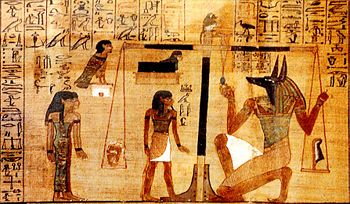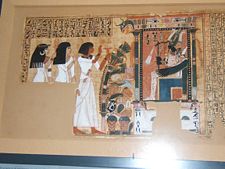Egyptian Book of the Dead
- For other uses, see Egyptian Book of the Dead (disambiguation).

The Book of the Dead is the common name for ancient Egyptian funerary texts known as The Book of Coming [or Going] Forth By Day. The name "Book of the Dead" was the invention of the German Egyptologist Karl Richard Lepsius, who published a selection of the texts in 1842.
Background
According to R.O. Faulkner, The Book of the Dead was used by the ancient Egyptians as a set of instructions for the afterlife. Not all the spells were used for every burial, but a selection depending on wealth and status. Some spells were gifts to the gods, while other were used so the person could walk, a spell for not dying again in the afterlife, and even a spell 'For preventing a man from going upside down and from eating feces' (chapter 189)
The text can also be seen as initiation literature into the mystery of the afterlife. The afterlife is mostly a mystery to the average Egyptian, but by obtaining a Book of the Dead, he would be able to read it and would be part of the elite group which knew what the afterlife contained.
Versions
The earliest known versions date from the 16th century B.C.E. during the New Kingdom, 18th Dynasty (ca. 1550-1292 B.C.E.). It partly incorporated two previous collections of Egyptian religious literature, known as the Coffin Texts (ca. 2000 B.C.E.) and the Pyramid Texts (ca. 2600 B.C.E.-2300 B.C.E.), both of which were eventually superseded by the Book of the Dead. The Book of the Dead for Scribe Ani, the Papyrus of Ani, was originally 78 ft (28 m), and was separated into thirty seven sheets at appropriate chapter and topical divisions.
The text was often individualized for the deceased person, so no two copies contain the same text. However, "book" versions containing similar features are generally categorized into four main divisions – the Heliopolitan version, which was edited by the priests of the college of Annu (used from the 5th to the 11th dynasty and on walls of tombs until about 200); the Theban version, which contained hieroglyphics only (20th to the 28th dynasty); a hieroglyphic and hieratic character version, closely related to the Theban version, which had no fixed order of chapters (used mainly in the 20th dynasty); and the Saite version which has strict order (used after the 26th dynasty).
Spell 125
Spell 125 is probably the best-known segment of the Book of the Dead. It deals with the dead soul's judgment by Osiris and his 42 judge deities.
The deceased soul must recite the "declaration of innocence" which is addressed to Osiris and consists of the denial of a series of wrong-doings in order to assure Osiris that he has lived a decent life. The deceased must then address the 42 judges by name and deny a further 42 transgressions (one per judge). If the deceased is subsequently found worthy he will be taken before Osiris who will lead him to the realm of the blessed.
The content of some of the statements of denial or the 'negative confession' (I have done no falsehood, I have not robbed, I have not killed men) has led some scholars to hypothesize that Spell 125 may be the basis for the Biblical Ten Commandments[1].
ReferencesISBN links support NWE through referral fees
- Thomas George Allen, The Egyptian Book of the Dead: Documents in the Oriental Institute Museum at the University of Chicago, Thomas George Allen, (University of Chicago Press, Chicago), c 1960.
- Thomas George Allen, The Book of the Dead or Going Forth by Day. Ideas of the Ancient Egyptians Concerning the Hereafter as Expressed in Their Own Terms, Thomas George Allen, (SAOC vol. 37; Small TextUniversity of Chicago Press, Chicago), c 1974.
- E. A. Wallis Budge, The Egyptian Book of the Dead,(The Papyrus of Ani), Egyptian Text, Transliteration, and Translation, E.A.Wallis Budge, (Dover (Note: 240 pages of running hieroglyphic text. NB: Budge's translations and transliterations are extremely outdated and are not generally cited by modern Egyptologists)
- Raymond O. Faulkner, The Ancient Egyptian Book of the Dead, translated by Raymond Faulkner, edited by Carol Andrews (University of Texas Press, Austin), c 1972.
- Raymond O. Faulkner, The Egyptian Book of the Dead, The Book of Going forth by Day. The First Authentic Presentation of the Complete Papyrus of Ani translated by Raymond Faulkner, edited by Eva von Dassow, with contributions by Carol Andrews and Ogden Goelet (Chronicle Books, San Francisco), c 1994.
- Gunther Lapp, The Papyrus of Nu (Catalogue of Books of the Dead in the British Museum), by Gunther Lapp, (British Museum Press, London), c 1997.
- Andrzej Niwinski, Studies on the Illustrated Theban Funerary Papyri of the 11th and 10th Centuries B.C.E., by Andrzej Niwinski, (OBO vol. 86; Universitätsverlag, Freiburg), c 1989.
External links
- Egyptian Book of the Dead
- Budge, E. A. Wallis, "Book of the Dead, The Papyrus of Ani".
- Online Readable Text, with several images and reproductions of Egyptian papyri
- The possible origin of the Ten Commandments
| Topics about Ancient Egypt edit | |||
|---|---|---|---|
| Places: Nile river | Niwt/Waset/Thebes | Alexandria | Annu/Iunu/Heliopolis | Luxor | Abdju/Abydos | Giza | Ineb Hedj/Memphis | Djanet/Tanis | Rosetta | Akhetaten/Amarna | Atef-Pehu/Fayyum | Abu/Yebu/Elephantine | Saqqara | Dahshur | |||
| Gods associated with the Ogdoad: Amun | Amunet | Huh/Hauhet | Kuk/Kauket | Nu/Naunet | Ra | Hor/Horus | Hathor | Anupu/Anubis | Mut | |||
| Gods of the Ennead: Atum | Shu | Tefnut | Geb | Nuit | Ausare/Osiris | Aset/Isis | Set | Nebet Het/Nephthys | |||
| War gods: Bast | Anhur | Maahes | Sekhmet | Pakhet | |||
| Deified concepts: Chons | Maàt | Hu | Saa | Shai | Renenutet| Min | Hapy | |||
| Other gods: Djehuty/Thoth | Ptah | Sobek | Chnum | Taweret | Bes | Seker | |||
| Death: Mummy | Four sons of Horus | Canopic jars | Ankh | Book of the Dead | KV | Mortuary temple | Ushabti | |||
| Buildings: Pyramids | Karnak Temple | Sphinx | Great Lighthouse | Great Library | Deir el-Bahri | Colossi of Memnon | Ramesseum | Abu Simbel | |||
| Writing: Egyptian hieroglyphs | Egyptian numerals | Transliteration of ancient Egyptian | Demotic | Hieratic | |||
| Chronology: Ancient Egypt | Greek and Roman Egypt | Early Arab Egypt | Ottoman Egypt | Muhammad Ali and his successors | Modern Egypt | |||
Credits
New World Encyclopedia writers and editors rewrote and completed the Wikipedia article in accordance with New World Encyclopedia standards. This article abides by terms of the Creative Commons CC-by-sa 3.0 License (CC-by-sa), which may be used and disseminated with proper attribution. Credit is due under the terms of this license that can reference both the New World Encyclopedia contributors and the selfless volunteer contributors of the Wikimedia Foundation. To cite this article click here for a list of acceptable citing formats.The history of earlier contributions by wikipedians is accessible to researchers here:
The history of this article since it was imported to New World Encyclopedia:
Note: Some restrictions may apply to use of individual images which are separately licensed.

